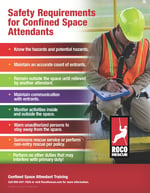 Newly revised and updated with 82-pages of color drawings and detailed illustrations, Roco's new Pocket Guide features techniques taught in our rescue classes. Made from synthetic paper that is impervious to moisture makes this pocket-sized guide the perfect reference during training or on the scene.
Newly revised and updated with 82-pages of color drawings and detailed illustrations, Roco's new Pocket Guide features techniques taught in our rescue classes. Made from synthetic paper that is impervious to moisture makes this pocket-sized guide the perfect reference during training or on the scene.
Pocket Guide features: Knots - Rigging - Patient Packaging - Lower/Hauling Systems - Tripod Operations - Low Angle - Pick-off Rescue - High-lines - Confined Spaces and much more.
Reference charts include: Confined Space Types, Suspension Trauma, and Rescue Gear Service Life Chart.
Click here to order your copy today!!

 Comments by Dennis O'Connell, Roco Director of Training & Chief Instructor
Comments by Dennis O'Connell, Roco Director of Training & Chief Instructor There continues to be a misconception that a confined space attendant (or “hole watch”) is a menial task to be assigned to the greenest, most inexperienced personnel on the job. That’s a dangerous assumption, and it has been a contributing factor in many confined space fatalities.
There continues to be a misconception that a confined space attendant (or “hole watch”) is a menial task to be assigned to the greenest, most inexperienced personnel on the job. That’s a dangerous assumption, and it has been a contributing factor in many confined space fatalities. Don’t allow unauthorized persons to approach or enter the permit space. If you are unable to warn them away, do order the evacuation of the authorized entrants. Do immediately inform the entry supervisor of the situation.
Don’t allow unauthorized persons to approach or enter the permit space. If you are unable to warn them away, do order the evacuation of the authorized entrants. Do immediately inform the entry supervisor of the situation.

 I then suggest that the team’s training records be reviewed in order to determine what level of training has been completed. I also strongly recommend getting everyone to the same level; especially if your facility is what I refer to as an “island unto itself.” In other words, do you have nearby facilities or other local agencies who can offer additional manpower, equipment, etc. in an emergency – or, are you fairly isolated?
I then suggest that the team’s training records be reviewed in order to determine what level of training has been completed. I also strongly recommend getting everyone to the same level; especially if your facility is what I refer to as an “island unto itself.” In other words, do you have nearby facilities or other local agencies who can offer additional manpower, equipment, etc. in an emergency – or, are you fairly isolated? 




